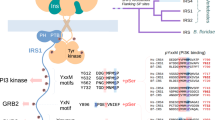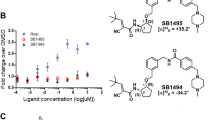Abstract
Obesity and type II diabetes are closely linked metabolic syndromes that afflict >100 million people worldwide. Although protein tyrosine phosphatase 1B (PTP1B) has emerged as a promising target for the treatment of both syndromes, the discovery of pharmaceutically acceptable inhibitors that bind at the active site remains a substantial challenge. Here we describe the discovery of an allosteric site in PTP1B. Crystal structures of PTP1B in complex with allosteric inhibitors reveal a novel site located ∼20 Å from the catalytic site. We show that allosteric inhibitors prevent formation of the active form of the enzyme by blocking mobility of the catalytic loop, thereby exploiting a general mechanism used by tyrosine phosphatases. Notably, these inhibitors exhibit selectivity for PTP1B and enhance insulin signaling in cells. Allosteric inhibition is a promising strategy for targeting PTP1B and constitutes a mechanism that may be applicable to other tyrosine phosphatases.
This is a preview of subscription content, access via your institution
Access options
Subscribe to this journal
Receive 12 print issues and online access
$189.00 per year
only $15.75 per issue
Buy this article
- Purchase on Springer Link
- Instant access to full article PDF
Prices may be subject to local taxes which are calculated during checkout







Similar content being viewed by others
References
Saltiel, A.R. New perspectives into the molecular pathogenesis and treatment of type 2 diabetes. Cell 104, 517–529 (2001).
Ahmad, F., Li, P.M., Meyerovitch, J. & Goldstein, B.J. Osmotic loading of neutralizing antibodies demonstrates a role for protein-tyrosine phosphatase 1B in negative regulation of the insulin action pathway. J. Biol. Chem. 270, 20503–20508 (1995).
Seely, B.L. et al. Protein tyrosine phosphatase 1B interacts with the activated insulin receptor. Diabetes 45, 1379–1385 (1996).
Kenner, K.A., Anyanwu, E., Olefsky, J.M. & Kusari, J. Protein-tyrosine phosphatase 1B is a negative regulator of insulin- and insulin-like growth factor-I-stimulated signaling. J. Biol. Chem. 271, 19810–19816 (1996).
Chen, H. et al. Protein-tyrosine phosphatases PTP1B and syp are modulators of insulin-stimulated translocation of GLUT4 in transfected rat adipose cells. J. Biol. Chem. 272, 8026–8031 (1997).
Elchebly, M. et al. Increased insulin sensitivity and obesity resistance in mice lacking the protein tyrosine phosphatase-1B gene. Science 283, 1544–1548 (1999).
Klaman, L.D. et al. Increased energy expenditure, decreased adiposity, and tissue-specific insulin sensitivity in protein-tyrosine phosphatase 1B-deficient mice. Mol. Cell. Biol. 20, 5479–5489 (2000).
Rondinone, C.M. et al. Protein tyrosine phosphatase 1B reduction regulates adiposity and expression of genes involved in lipogenesis. Diabetes 51, 2405–2411 (2002).
Zinker, B.A. et al. PTP1B antisense oligonucleotide lowers PTP1B protein, normalizes blood glucose, and improves insulin sensitivity in diabetic mice. Proc. Natl. Acad. Sci. USA 99, 11357–11362 (2002).
Johnson, T.O., Ermolieff, J. & Jirousek, M.R. Protein tyrosine phosphatase 1B inhibitors for diabetes. Nat. Rev. Drug Discov. 1, 696–709 (2002).
Wrobel, J. et al. PTP1B inhibition and antihyperglycemic activity in the ob/ob mouse model of novel 11-arylbenzo[b]naphtho[2,3-d]furans and 11- arylbenzo[b]naphtho[2,3-d]thiophenes. J. Med. Chem. 42, 3199–3202 (1999).
Barford, D., Flint, A.J. & Tonks, N.K. Crystal structure of human protein tyrosine phosphatase 1B. Science 263, 1397–1404 (1994).
Jia, Z., Barford, D., Flint, A.J. & Tonks, N.K. Structural basis for phosphotyrosine peptide recognition by protein tyrosine phosphatase 1B. Science 268, 1754–1758 (1995).
Puius, Y.A. et al. Identification of a second aryl phosphate-binding site in protein- tyrosine phosphatase 1B: a paradigm for inhibitor design. Proc. Natl. Acad. Sci. USA 94, 13420–13425 (1997).
Iversen, L.F. et al. Structure-based design of a low molecular weight, nonphosphorus, nonpeptide, and highly selective inhibitor of protein-tyrosine phosphatase 1B. J. Biol. Chem. 275, 10300–10307 (2000).
Segel, I.W. Enzyme Kinetics (Wiley, New York, 1993).
Pannifer, A.D., Flint, A.J., Tonks, N.K. & Barford, D. Visualization of the cysteinyl-phosphate intermediate of a protein-tyrosine phosphatase by X-ray crystallography. J. Biol. Chem. 273, 10454–10462 (1998).
Denu, J.M., Lohse, D.L., Vijayalakshmi, J., Saper, M.A. & Dixon, J.E. Visualization of intermediate and transition-state structures in protein-tyrosine phosphatase catalysis. Proc. Natl. Acad. Sci. USA 93, 2493–2498 (1996).
Dadke, S., Kusari, J. & Chernoff, J. Down-regulation of insulin signaling by protein-tyrosine phosphatase 1B is mediated by an N-terminal binding region. J. Biol. Chem. 275, 23642–23647 (2000).
Bleasdale, J.E. et al. Small molecule peptidomimetics containing a novel phosphotyrosine bioisostere inhibit protein tyrosine phosphatase 1B and augment insulin action. Biochemistry 40, 5642–5654 (2001).
Xie, L. et al. Cellular effects of small molecule PTP1B inhibitors on insulin signaling. Biochemistry 42, 12792–12804 (2003).
Salmeen, A., Andersen, J.N., Myers, M.P., Tonks, N.K. & Barford, D. Molecular basis for the dephosphorylation of the activation segment of the insulin receptor by protein tyrosine phosphatase 1B. Mol. Cell 6, 1401–1412 (2000).
Freire, E. Can allosteric regulation be predicted from structure. Proc. Natl. Acad. Sci. USA 97, 11680–11682 (2000).
Luque, I. & Freire, E. Structural stability of binding sites: consequences for binding affinity and allosteric effects. Proteins 41 (suppl.), 63–71 (2000).
Andersen, J.N. et al. Structural and evolutionary relationships among protein tyrosine phosphatase domains. Mol. Cell. Biol. 21, 7117–7136 (2001).
Hao, L., Tiganis, T., Tonks, N.K. & Charbonneau, H. The noncatalytic C-terminal segment of the T cell protein tyrosine phosphatase regulates activity via an intramolecular mechanism. J. Biol. Chem. 272, 29322–29329 (1997).
Streuli, M., Krueger, N.X., Thai, T., Tang, M. & Saito, H. Distinct functional roles of the two intracellular phosphatase like domains of the receptor-linked protein tyrosine phosphatases LCA and LAR. EMBO J. 9, 2399–2407 (1990).
Nam, H.J., Poy, F., Krueger, N.X., Saito, H. & Frederick, C.A. Crystal structure of the tandem phosphatase domains of RPTP LAR. Cell 97, 449–457 (1999).
Flint, A.J., Gebbink, M.F., Franza, B.R., Jr., Hill, D.E. & Tonks, N.K. Multi-site phosphorylation of the protein tyrosine phosphatase, PTP1B: identification of cell cycle regulated and phorbol ester stimulated sites of phosphorylation. EMBO J. 12, 1937–1946 (1993).
Liu, F., Hill, D.E. & Chernoff, J. Direct binding of the proline-rich region of protein tyrosine phosphatase 1B to the Src homology 3 domain of p130(Cas). J. Biol. Chem. 271, 31290–31295 (1996).
Teague, S.J. Implications of protein flexibility for drug discovery. Nat. Rev. Drug Discov. 2, 527–541 (2003).
Christopoulos, A. Allosteric binding sites on cell-surface receptors: Novel targets for drug discovery. Nat. Rev. Drug Discov. 1, 198–210 (2002).
Schindler, T. et al. Structural mechanism for STI-571 inhibition of abelson tyrosine kinase. Science 289, 1938–1942 (2000).
Williams, D.H. & Mitchell, T. Latest developments in crystallography and structure-based design of protein kinase inhibitors as drug candidates. Curr. Opin. Pharmcol. 2, 1–7 (2002).
Pargellis, C. et al. Inhibition of p38 MAP kinase by utilizing a novel allosteric binding site. Nat. Struct. Biol. 9, 268–272 (2002).
Erlanson, D.A. et al. Discovery of a new phosphotyrosine mimetic for PTP1B using breakaway tethering. J. Am. Chem. Soc. 125, 5602–5603 (2003).
Andersen, H.S. et al. 2-(oxalylamino)-benzoic acid is a general, competitive inhibitor of protein-tyrosine phosphatases. J. Biol. Chem. 275, 7101–7108 (2000).
Pflugrath, J.W. The finer things in X-ray diffraction data collection. Acta Crystallogr. D 55, 1718–1725 (1999).
Collaborative Computational Project, Number 4. The CCP4 suite: programs for protein crystallography. Acta Crystallogr. D 50, 760–763 (1994).
Jones, T.A., Zou, J.Y., Cowan, S.W. & Kjeldgaard, M. Improved methods for building protein models in electron density maps and the location of errors in these models. Acta Crystallogr. A 47, 110–119 (1991).
Acknowledgements
We thank S. Evarts and M. Cancilla for assistance with mass spectrometry; J. Smith for assistance with protein purification; S. Lam, T. Webb, and A. Shi for compound purification; J. Wells and E. Gordon for outstanding scientific consultations and enthusiastic support; and A. Weiss, J. Wells, B. Cunningham, M. Romanowski and T. O'Brien for critical reading of the manuscript. The work was supported in part by US National Institutes of Health small business innovation research grant R43-DK063764 to R.S.M and S.K.H.
Author information
Authors and Affiliations
Corresponding author
Ethics declarations
Competing interests
The authors declare no competing financial interests.
Supplementary information
Supplementary Video 1
Conformational changes between the closed conformation and the allosteric-inhibited conformation in the presence of compound 1. (MOV 3081 kb)
Tyr(P) (green) is shown in the active site in the closed conformation, but Tyr(P) dims as the conformation switches into the allosteric inhibited form. WPD loop and flanking residues are shown in purple, α3 in green, α6 in orange, and α7 in red. Trp291 on α7 is also shown. The structure in PDB entry 1PTY was used as a reference for the closed conformation. Created using the program PyMOL (DeLano Scientific, http://www.pymol.org).
Rights and permissions
About this article
Cite this article
Wiesmann, C., Barr, K., Kung, J. et al. Allosteric inhibition of protein tyrosine phosphatase 1B. Nat Struct Mol Biol 11, 730–737 (2004). https://doi.org/10.1038/nsmb803
Received:
Accepted:
Published:
Issue Date:
DOI: https://doi.org/10.1038/nsmb803
This article is cited by
-
Myeloid PTP1B deficiency protects against atherosclerosis by improving cholesterol homeostasis through an AMPK-dependent mechanism
Journal of Translational Medicine (2023)
-
A small molecule inhibitor of PTP1B and PTPN2 enhances T cell anti-tumor immunity
Nature Communications (2023)
-
Deconstructing allostery by computational assessment of the binding determinants of allosteric PTP1B modulators
Communications Chemistry (2023)
-
Inhibition of PTP1B by isosinensetin, a polymethoxylated flavone isolated from trifoliate orange peel: kinetic studies, molecular docking, and molecular dynamics simulation
Chemical Papers (2023)
-
Advances of Predicting Allosteric Mechanisms Through Protein Contact in New Technologies and Their Application
Molecular Biotechnology (2023)



